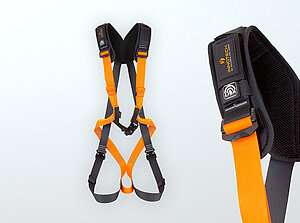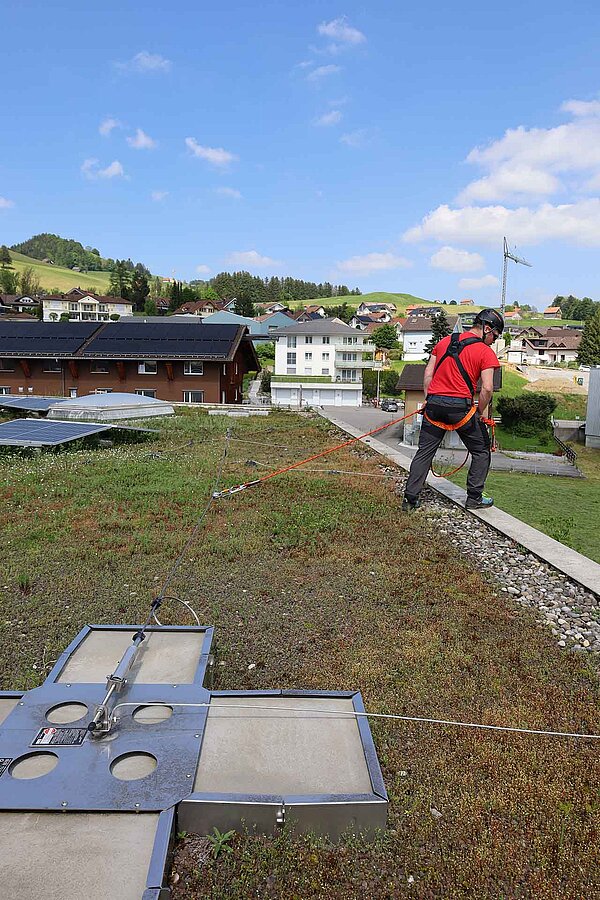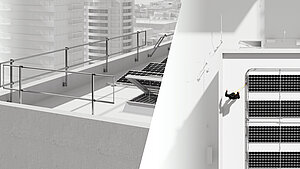The fall factor is a term used in connection with fall protection systems as a means to describe the ratio between the fall height and the released rope length. An indicator of key importance, it must be taken into account when planning and performing activities in vertical structures, such as work involving climbing or working at height.
This wiki post deals exclusively with the fall factor calculation for work at height or in the context of fall protection systems and rope-assisted work procedures. Familiarity with the fall factor and the forces that occur is vital for the ability to select the right protective equipment against falls from a height and to take the relevant precautions to ensure safety.
The fall factor indicates which absolute forces - in the event of a fall - act on the rope and the protective equipment. A low fall factor is desirable because the fall energy to be absorbed is lower, reducing the risk of injury to the human body.
Fall factor = fall height resulting from the released rope length
The theoretical fall factor is determined by the following physical factors: Ratio of fall height to released rope length. The assumption is that the entire kinetic energy of the fall is absorbed by the rope - or the lanyard - and by the personal protective equipment. This value is established in theoretical, standardized test conditions and serves as a guideline for the load limit of the equipment.
- Consequently, the decisive factor for the calculation of the fall factor is the distance of the secured person to the ground (or the impact surface). This distance corresponds to the fall height.
- The total length of the lanyard from secured person to anchor point corresponds to the total length of rope that takes the fall - this is the released rope length.
Sample fall factor calculation: A fall height of 5 metres plus a released rope length of 2.5 metres equals a fall factor of 2.
While the ropes used for climbing are dynamic ropes, the ropes used for fall protection are exclusively static and include a shock absorber or fall arrest device.

Personal Protective Equipment PPE
Whether on roofs, scaffolding, ladders, facades, or other fall-risk areas, compliant high-quality equipment for fall protection is an absolute must.
Secure connection between user and safety system
Our PPE personal protective equipment creates a secure connection between user and fall protection systems. Depending on application and situation, it provides optimum comfort, and impresses through its top quality.

PPE LANYARDS
PERSONAL PROTECTIVE EQUIPMENT PPE
PPE LANYARDS are the secure connection to INNOTECH anchor points. There are a number of variations which fulfil the respective requirements in terms of operation and loading.

PPE ASSOCIATED EQUIPMENT
PERSONAL PROTECTIVE EQUIPMENT PPE
PPE ASSOCIATED EQUIPMENT from INNOTECH is the ideal addition to the INNOTECH harness models. Their purpose is to extend the use of the harnesses in their respective applications, and they provide practical solutions for cable access technology.
Fall factor 0, 1 and 2
The higher the fall factor, the greater the energy that acts on the equipment and the user. A lower fall factor is safer because it transfers less energy and load to the system. The fall factor in fall protection has different levels:
Fall factor 0: This value signifies that - in the event of a fall - no additional loads act on the safety equipment, as the fall height is equal to the length of the released rope. In other words: The user is already suspended in the system.
Fall factor 1: A fall with a factor of 1 means that the fall height is exactly as high as the released rope length. This is a common and safe standard that is applied in many fall protection systems. Corresponds to, for example, 4 metres of drop height and 4 metres of lanyard.
Fall factor 2: Here, the fall height is twice the amount of the released rope length. Representing the maximum fall factor, it constitutes a safety standard that is designed to minimize the risk of injury in the event of falls. Corresponds to, for example, 6 metres of fall height and 3 metres of released lanyard.
The resulting forces acting on the falling person increase with the number of the fall factor. You should therefore pay attention to the lowest possible fall factor.
Practical tips for a low fall factor and safe work
Take precautions to avoid a high fall factor and always consider all contributing factors when selecting your fall protection system. Here are a few practical tips for a low load or for keeping low the acting forces in the event of a fall with a fall factor:
- The anchor point used should be positioned as far as possible above the user.
- The anchor point used should never be below your own feet.
- The lanyard should be kept as short as possible.
- Use caution with lanyards where the length can be altered by the user. The possibility of user errors results in greater risk and possibly a high fall factor.
Do not hesitate to contact experts if you are unsure about the selection and configuration of the appropriate fall protection system. Too high a fall factor can have serious consequences for the human body.







![[Translate to Englisch:] [Translate to Englisch:]](https://www.innotech-safety.com/fileadmin/_processed_/f/b/csm_Pendelsturz-Volkshaus-Zuerich_ab9c27d467.jpg)